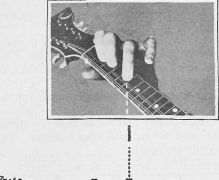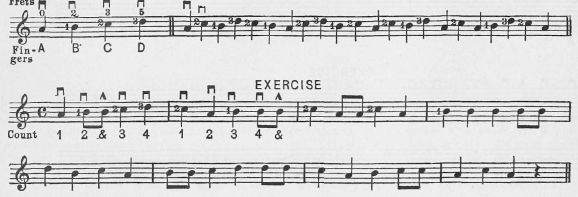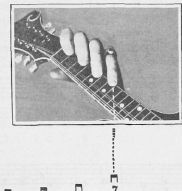Mandolin Self Instructor, online tutorial - Page 20
A simplified self learning system for the Mandolin with tuning instruction, song folio, chord diagrams, sheet music and PDF for printing. By ZARH MYRON BICKFORD
| Share page | Visit Us On FB |
|
NOTES ON THE A STRING |
|||
 |
The notes laying between the open A and E strings (B-C-D), are pro-
duced on the A string, B being made with the first finger at the second fret, C with the second finger at the third fret and D with the third finger at the fifth fret, as shown in the illustration. In each case the fingers remain firmly on the string, so that by the time the D is reached, the three fingers are in place, as shown in the cut. It will be noticed that in this and the other similar Exercises the notes are not divided off into groups or measures. They should, however, be played as evenly as possible and invariably with down strokes, the up strokes being reserved for the second of a pair of eighth notes. Particular attention must also be paid to the manner in which the strokes are made, making them in the vigorous manner prescribed under a previous heading. These are invariable rules and must be followed. |
||
 |
|||
|
NOTES ON THE E STRING |
|||
|
All notes above the open E string are produced on this string, for the present, at least.
This includes F-G-A and B, this marking the limit or extent of what is known as the first position—that is to say,
that position of the hand in which the first finger plays or stops theirs/ note or letter on each string, not counting the open string. Other positions, in which the hand moves higher up the fingerboard (toward the bridge), are explained in a later volume of this Method. The F on this string is made by placing the first finger at the first fret.
This note will be found a little more difficult to make than the notes made with this finger on the other strings, but
it is only necessary to close the joints of the finger a little tighter than usual, so that the tip rests against the first fret, the position of the thumb and the hand in general remaining the same as before. G is made at the third fret, with the second finger, the first remain-
ing on the F in the meantime. The third finger is placed at the fifth fret for A, both the first and second remaining in their places. It is now necessary to use the fourth finger for B at the seventh fret, as shown in the illustration. All the other fingers must remain in their places while this finger is stretched to the seventh fret. For the purpose of loosen- ing the muscles and tendons of the hand and fingers and making them more pliable, it is suggested that the joints and the fleshy part of the hand at the base of the fingers be kneaded or massaged and also that the fingers be gently stretched apart by forcing the closed fingers of the right hand between each pair. Particular attention must be paid to the position of all the fingers and the thumb when making this B, as shown in the illustration, and the position of the thumb should be compared with that shown when the first finger makes the A on the G string.  |
|||
 |
|||